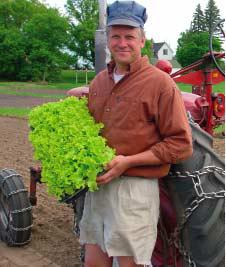Beyond Organic

Organic food is still growing at a remarkable clip, especially now that this “pure product” has made the leap from food co-ops to megastores like Wal-Mart, which is infamous for driving down wholesale prices and paying nada wages to workers.
But with no social justice component in sight for USDA organic standards, many co-op customers and other ethical shoppers are turning their attention to Fair Trade. These consumers would like to know that U.S. farmers, along with international Fair Trade coffee growers, are making a decent profit on the food they grow and that farm laborers have been paid well for their hard work.
Unfortunately, that’s easier said than done: Inexpensive food is financed by cheap labor in this country. According to the USDA’s own study, “About 45 percent of all hired farm workers 25 years and older…earn less than the poverty threshold for a family of four. Over one-third have annual family incomes of less than $15,000.” And according to another recent study, most farmers who work 100 acres or fewer have an average net profit of minus 20 percent.
To address these unsustainable elements in our marketplace, groups like the Local Fair Trade Network (LFTN) in the Twin Cities are gathering co-op groceries, sustainable farmers, and farm labor organizations together in order to create a label that will be meaningful to consumers
Furthermore, LFTN is acting as the Fair Trade “pilot program” for the Agricultural Justice Project (AJP) out of North Carolina. The goal is to construct a set of standards that would give credibility to a Domestic Fair Trade label. “[Agricultural Justice Project] has been creating the standards for Fair Trade for years,” says Erik Esse, Director of LFTN, explaining how that partnership came about. “Now they’re working with a small group of farmers that they will be able to certify as truly Fair Trade next growing season.”
Don’t wait. Cooperate!
Esse, who also serves as the merchandising and marketing coordinator for North Country Cooperative in Minneapolis, says that grocery co-op buy-in is essential for the good intentions of this Fair Trade movement to gel into a marketplace force. “Consumer co-ops are where the resources are. They have their own publicity and marketing departments and can coordinate in ways that no individual co-op could do.” Plus, says Esse, co-ops have expertise in presenting abstract concepts like sustainability and social justice to the consumer—a real boon for the burgeoning Fair Trade movement.
“Co-ops have always been the forefront of any food movement,” says Joe Riemann, the National Cooperative Grocers Association’s liaison on Domestic Fair Trade. He also serves on the steering committee for the LFTN pilot project. “Our shoppers care where their food comes from, where it’s produced. This is something that fits well within [our] principles.”
But paying a living wage to farm workers and a return of profit to farmers is going to cost—and that money has to come from somewhere.
Greg Reynolds of Riverbend Farm in Delano, Minnesota, is a strong supporter of Domestic Fair Trade, but says that customers and co-ops should understand what a Fair Trade label might require. According to Reynolds, if he were to pay his workers a living wage, his produce prices would increase anywhere from 15 to 30 percent.
Will co-op shoppers pay more for Domestic Fair Traded produce? Riemann says, “People are already paying a premium for local so they already understand the implications of buying direct and making sure we have a sustainable food system.”
Sean Doyle, general manager of Seward Co-op in Minneapolis, says that Domestic Fair Trade will resonate with his shoppers and members. “I think ethical shoppers would like the assurance that the product is Fair Trade, but if they have that assurance, they’ll buy the product regardless of price.” Doyle also says that creating a certification process will make the label more transparent and resonate with a broader grocery market.
“The good news is that there’s a precedent with organics,” says Esse. “People said paying more for their groceries never would have worked—and that did work.”
Then there’s democracy and fairness in the workplace to consider, especially for farm workers who aren’t often in a position to act collectively. “For them to be full partners is a real challenge,” Esse says, referring to cultural, language, and political barriers. As a result, LFTN has begun working with and seeking guidance from Centro Campesino, a regional farmworker organization.
There’s a particular road, of course, that’s been paved with good intentions. Avoiding that road, as Doyle suggests, will require stringent, credible standards. Big Organic’s clean reputation has been smudged, after all, because USDA organic standards were perceived to have been eroded.
But so far, the Domestic Fair Trade effort seems genuine, with players like Organic Valley, Equal Exchange, and NCGA all taking an active interest in a meaningful label. “It’s successful to bring all these people and farm workers into the same room,” Says Riemann. “All these people who are practicing Fair Trade in various capacities—lots of heavy lifting. That’s a success in itself.”







